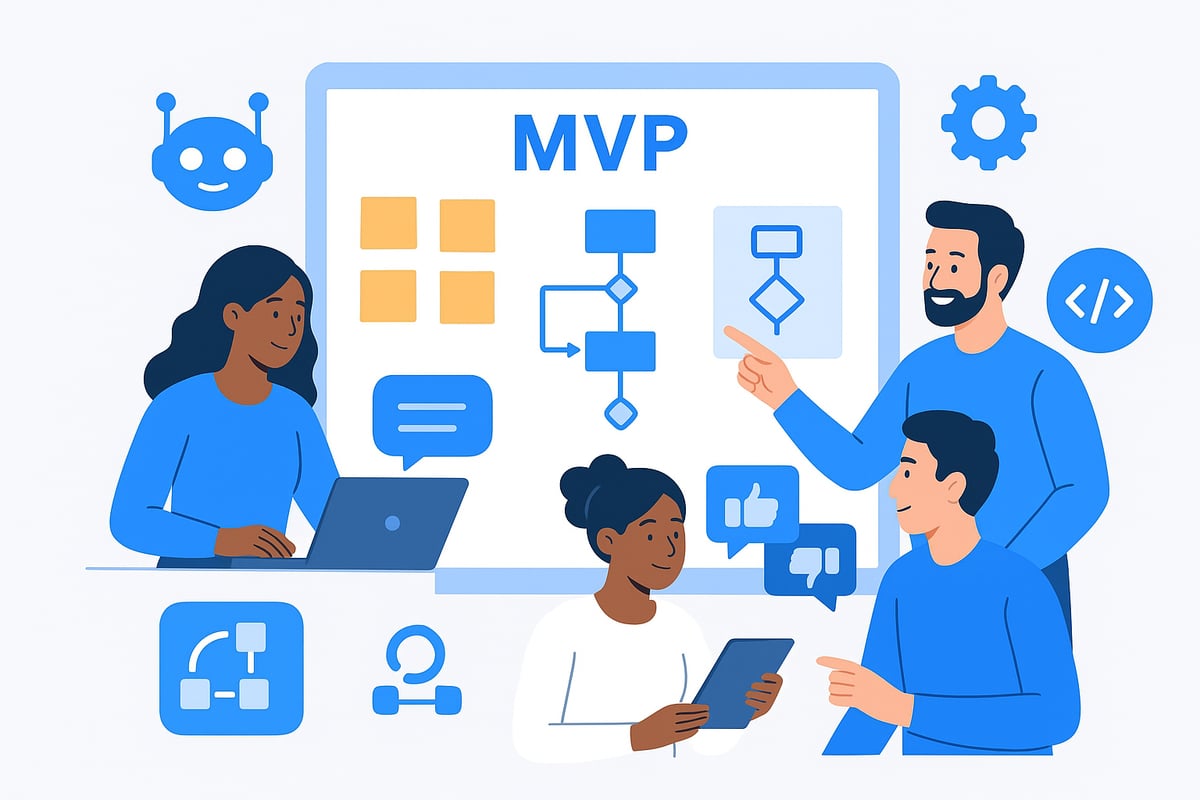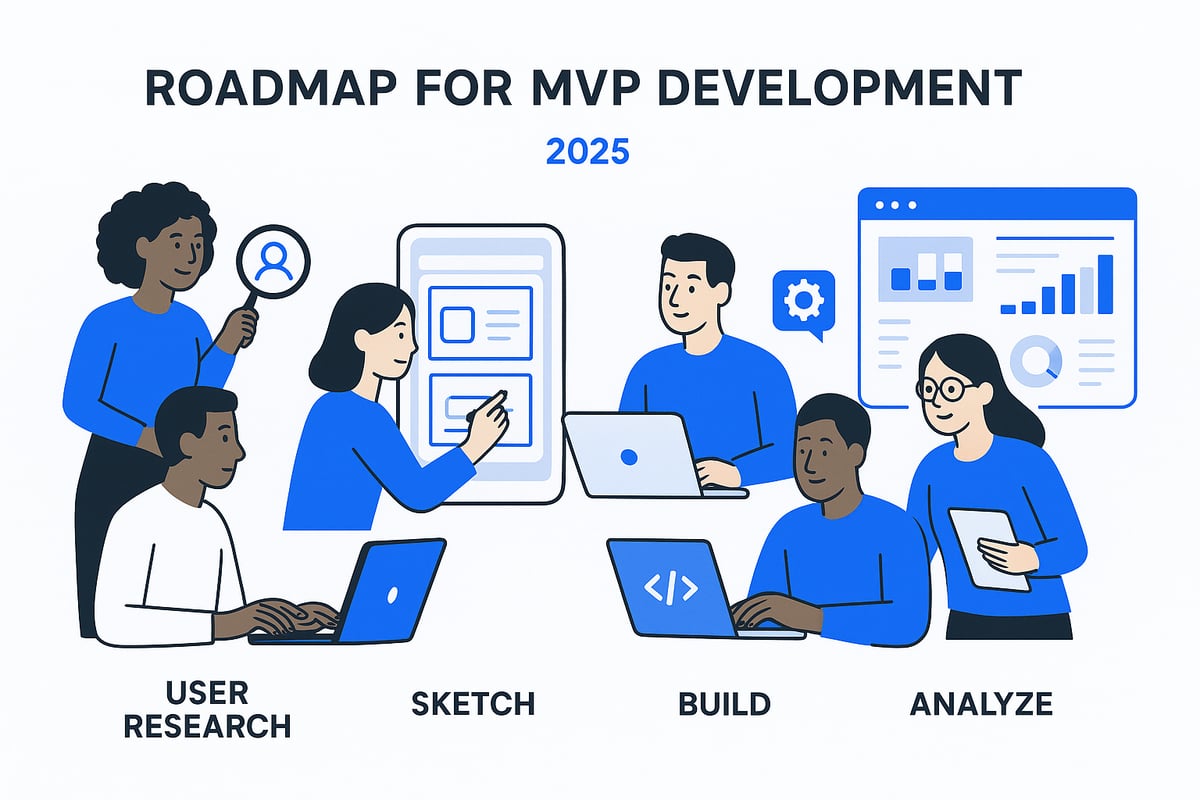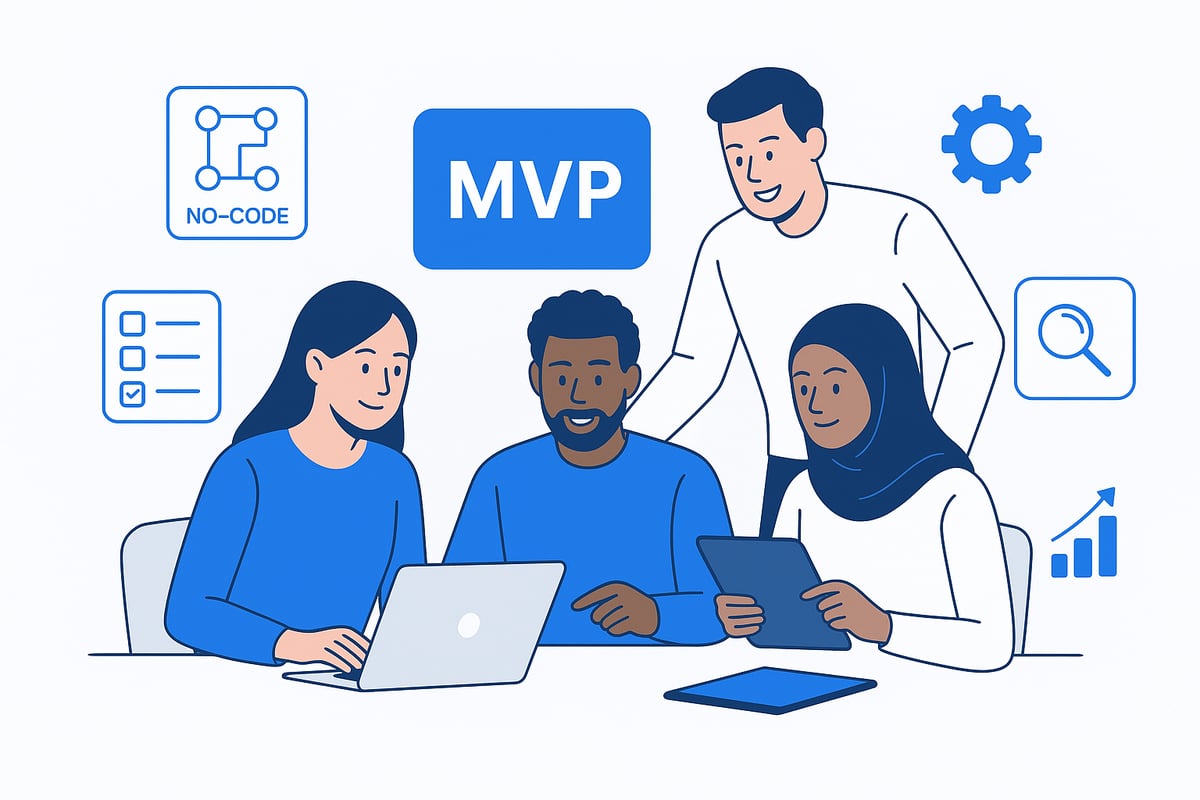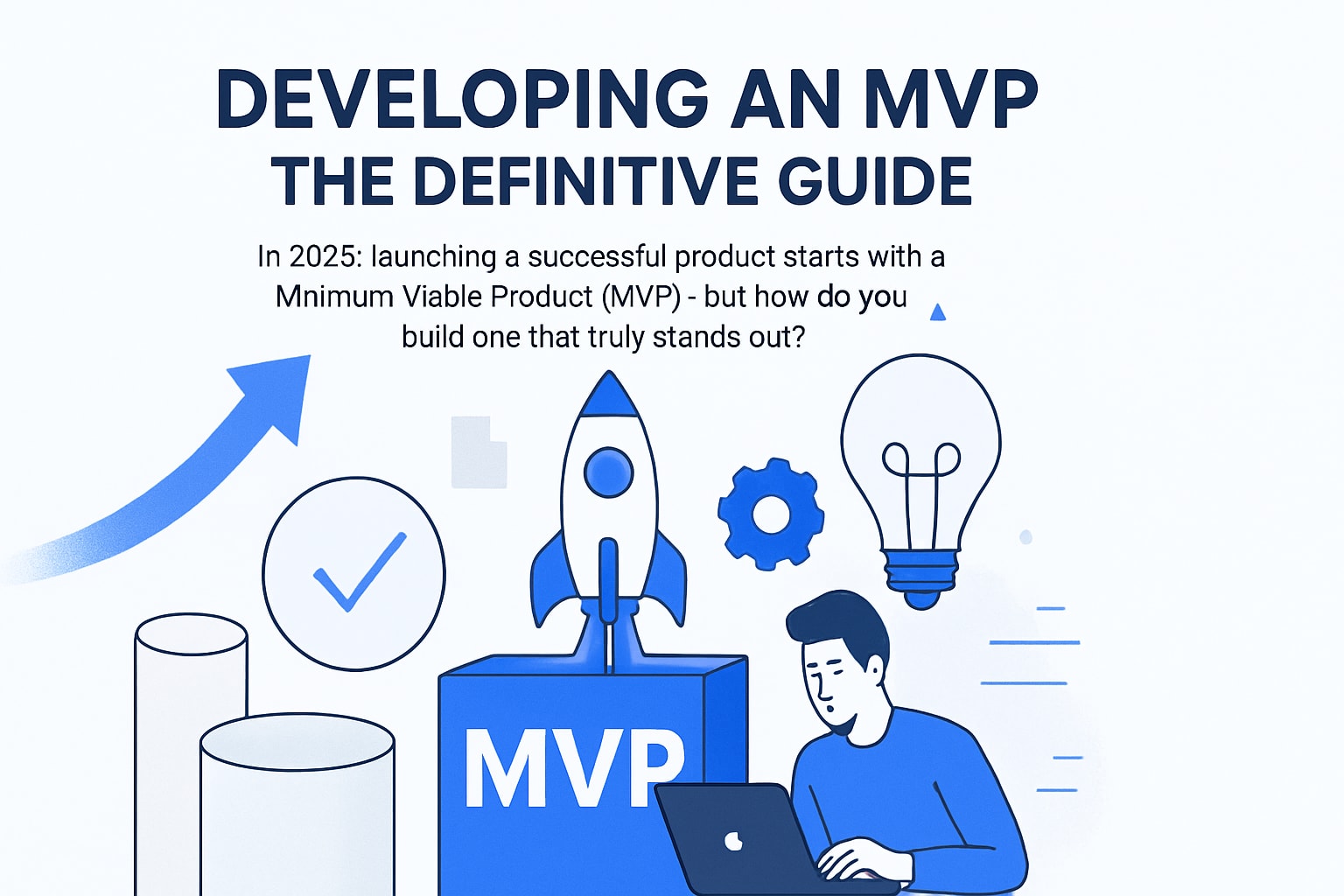In 2025, rapid innovation means that developing an mvp is no longer optional—it is the foundation for any successful product launch. But what separates an average MVP from one that leads the market?
This guide will show you the full process of developing an mvp, from defining what an MVP really is to step-by-step creation, top tools, and avoiding common mistakes.
You will find actionable strategies, insights from real-world examples, and a clear roadmap to measure your MVP’s success. Ready to turn your big idea into a winning product? Let’s get started.
What is an MVP and Why is it Critical in 2025?
Understanding the concept of developing an mvp is essential in the fast-paced tech landscape of 2025. An MVP, or Minimum Viable Product, is far more than just a buzzword. It is the foundation for building products that meet real user needs and adapt quickly to market shifts.

Defining the Minimum Viable Product
A Minimum Viable Product is a version of a new product that includes only the core features needed to satisfy early adopters and gather valuable feedback. Unlike a prototype, which is often just a visual or functional draft, an MVP is a usable product that customers can interact with. In contrast to a full-scale launch, developing an mvp means focusing on essentials before broad expansion.
| Product Stage | Purpose | User Interaction |
|---|---|---|
| Prototype | Visual/functional draft | Limited |
| MVP | Core features, real users | Active |
| Full Launch | Complete product | Broad |
Over the last decade, MVPs have evolved dramatically. The rise of no-code platforms and AI tools has made developing an mvp faster, more accessible, and more data-driven than ever.
Why MVPs Matter More Than Ever
Speed and efficiency are critical. Developing an mvp allows teams to get to market quickly and reduce upfront costs. According to CB Insights (2023), startups that embrace MVPs are 2.5x more likely to secure funding.
MVPs help validate market demand before making large investments. By testing with real users, teams can avoid costly mistakes and build with confidence. This approach ensures that limited resources are used wisely.
2025 Trends Impacting MVP Development
In 2025, the MVP landscape is shaped by no-code and low-code platforms, as well as AI integration. These technologies allow teams to build, test, and iterate products at unprecedented speeds. Rising competition and customer expectations mean that rapid iteration is no longer optional.
Even major brands like Airbnb and Dropbox started with simple MVPs. For a practical guide on leveraging no-code platforms for MVPs, see Building MVPs with No-Code Tools.
Key Benefits of MVP Approach
The benefits of developing an mvp are clear and measurable:
- Faster feedback loops from real users
- Improved chances of reaching product-market fit
- Lower risk of investing in the wrong features
- Ability to pivot quickly based on user data
These advantages help teams stay agile and responsive in a competitive environment.
Common Misconceptions About MVPs
There are several myths about MVPs:
- MVP does not mean low quality; it's about focusing on value.
- An MVP is not the final product; ongoing iteration is expected.
- MVPs are not just for startups; enterprises benefit too.
Understanding these truths is vital for anyone developing an mvp in 2025.
MVPs for Startups vs. Enterprises
The approach to developing an mvp varies by organization size. Startups often focus on launching fast with minimal resources, while enterprises may use MVPs for internal tool development or innovation labs.
For example, large companies frequently pilot MVPs to test new workflows before rolling out solutions company-wide. This reduces risk and aligns teams around real user needs.
The MVP Lifecycle in Modern Product Development
Integrating MVPs into agile and lean methodologies is now standard practice. Developing an mvp is not a one-time event but a continuous cycle of learning, building, measuring, and improving.
This lifecycle encourages teams to adapt based on user feedback and changing market conditions. Continuous learning is key to long-term product success.
Step-by-Step Process: How to Develop an MVP in 2025
Bringing a new idea to life in 2025 requires a smart, structured approach. Developing an mvp is all about moving quickly, learning fast, and minimizing risk. Let’s break down the exact steps you need to follow to go from concept to a real, testable product.

Step 1: Identify and Validate the Core Problem
Everything starts with understanding the real pain point you want to solve. Developing an mvp means you must validate that the problem is genuine, urgent, and widespread. Use tools like surveys, one-on-one interviews, and competitor analysis to dig deep into user needs.
Look for patterns in the feedback. Leverage Google Trends and social listening platforms to spot emerging demands. The goal is to avoid building something nobody wants. By focusing on the core problem, you set a solid foundation for developing an mvp that customers will actually care about.
Step 2: Define Success Metrics and Hypotheses
Before you start building, decide how you’ll measure success. Developing an mvp is about testing hypotheses, not just creating a product. Set clear, measurable goals using the SMART framework (Specific, Measurable, Achievable, Relevant, Time-bound).
For example, you might aim for 200 signups in your first month or a 20% retention rate after week one. Remember, 70% of failed startups cite unclear KPIs as a major factor. When developing an mvp, success metrics keep your team aligned and focused on outcomes rather than just outputs.
Step 3: Map Out the Core Features
Once you know the problem and the goals, it’s time to decide what to build. Developing an mvp requires ruthless prioritization. Use frameworks like MoSCoW (Must-have, Should-have, Could-have, Won’t-have) or the Kano model to rank features by importance.
Avoid feature creep by focusing only on essentials. Dropbox famously started with just a simple explainer video to validate interest. By stripping down to the basics, developing an mvp becomes faster, cheaper, and more effective at collecting real user feedback.
Step 4: Design User Experience and User Interface
A great product isn’t just about features. Developing an mvp means making your solution easy and enjoyable to use from day one. Start with wireframes using tools like Figma or Sketch to map out the user journey.
Remember, 88% of users abandon apps with poor UX. Test your designs early with real users to identify pain points. Intuitive design and a clean interface are critical to ensure that people actually try your MVP and provide valuable feedback.
Step 5: Choose the Right Tech Stack and Tools
Your technology choices can make or break your speed to market. When developing an mvp in 2025, you’ll likely evaluate no-code, low-code, and traditional development options. No-code platforms like Bubble and Webflow are gaining ground for their speed and flexibility.
To dive deeper, check out this overview of No-Code Tools for MVP Development in 2025, which highlights top platforms and their use cases. AI integration is also increasingly common, helping automate tasks and personalize user experiences. Choose tools that match your team’s skills and project goals for a smooth developing an mvp process.
Step 6: Build, Test, and Iterate Rapidly
Now, start building. Developing an mvp is all about moving quickly and learning from real users. Use agile sprints to break work into manageable chunks and deploy updates often. Get your MVP in front of users as soon as possible, even if it’s rough around the edges.
Collect feedback, fix bugs, and improve. Zappos started with a simple website to test demand before investing in inventory or infrastructure. Rapid iteration is the secret to developing an mvp that truly fits the market.
Step 7: Launch and Measure MVP Performance
It’s time to go live. Developing an mvp doesn’t end at launch; it’s just the beginning. Roll out your MVP with a clear go-to-market plan. Use analytics tools like Mixpanel or Google Analytics to track key metrics.
Monitor user signups, retention, engagement, and feedback. Adjust your roadmap based on what the data tells you. Remember, the best part of developing an mvp is learning what works so you can scale or pivot with confidence.
Choosing the Right Tools and Technologies for MVP Development
Selecting the right tools is essential for developing an mvp that stands out in 2025. The landscape is evolving quickly, and your tech choices can be the difference between a rapid launch and a stalled project. Let’s break down the key platforms and technologies that can supercharge your MVP journey.

No-Code and Low-Code Platforms
No-code and low-code platforms are revolutionizing how teams are developing an mvp. Tools like Bubble, Webflow, and Adalo enable rapid prototyping and iteration without traditional coding. This approach drastically reduces cost and development time, making it ideal for both startups and enterprises.
In 2024, 45% of MVPs used no-code solutions. Curious about the differences between no-code and low-code? Learn more in this No-Code vs. Low-Code Key Differences guide.
- Bubble: Drag-and-drop web app builder
- Webflow: Visual website design and launch
- Adalo: Mobile app creation for non-coders
Choosing the right platform depends on your team’s skills and the complexity of developing an mvp.
AI and Automation in MVPs
AI is changing the game for developing an mvp by enabling smarter features and automation from day one. Integrate personalization, analytics, and workflow automation using tools like Lovable, OpenAI APIs, and Zapier.
For example, fintech and healthtech MVPs increasingly use AI for fraud detection or patient triage, even in early versions. These integrations help you gather valuable data and improve user engagement, making developing an mvp more effective and future-ready.
Traditional Coding vs. Modern Alternatives
Sometimes, developing an mvp requires custom code to deliver unique value or handle complex logic. Traditional stacks like React, Node.js, and Flutter offer full flexibility. However, hybrid approaches—combining no-code frontends with coded backends—are gaining traction.
Decide based on your MVP’s complexity, scalability needs, and available talent. For most simple products, no-code and low-code can cover 80% of requirements, accelerating the process of developing an mvp.
Essential Design and Prototyping Tools
First impressions matter when developing an mvp. Use tools like Figma, Sketch, and InVision to wireframe, prototype, and iterate quickly. These platforms enable collaborative workflows, letting designers, developers, and stakeholders work in sync.
- Figma: Real-time collaboration for UI/UX design
- Sketch: Popular for Mac-based design workflows
- InVision: Interactive prototyping and feedback
A polished prototype helps validate ideas and streamline the process of developing an mvp.
Collaboration and Project Management Tools
Effective teamwork is vital when developing an mvp. Platforms like Notion, Trello, and Jira facilitate project tracking, task assignment, and transparent communication.
- Notion: All-in-one workspace for notes, docs, and tasks
- Trello: Visual kanban boards for workflow management
- Jira: Advanced project management for agile teams
Using these tools ensures everyone is aligned and helps avoid common pitfalls in developing an mvp.
Testing and QA Platforms
Quality assurance is non-negotiable for developing an mvp. Automated testing tools such as Selenium and TestCafe help catch bugs early and improve user experience. Continuous testing throughout the MVP lifecycle ensures your product meets user expectations and scales smoothly.
Early and frequent testing reduces the risk of critical errors and supports a reliable, scalable MVP foundation.
Common Pitfalls and Mistakes to Avoid in MVP Development
Launching a new product is exciting, but developing an mvp comes with hidden challenges. Even the most promising ideas can stumble if you fall into common traps. Knowing what to avoid is just as important as knowing the right steps. For a deeper dive into these issues, check out Common Pitfalls in Software Development.

Overbuilding and Feature Creep
One of the biggest mistakes in developing an mvp is adding too many features too soon. Teams often want to impress users, but this leads to complexity and delays. Remember, your MVP should focus only on core features that solve the main problem. Cutting non-essential features keeps your product simple and lets you launch faster.
- Focus on must-haves, not nice-to-haves
- Use feature prioritization models like MoSCoW
- Launch with a clear value proposition
Overbuilding increases costs and can confuse users, making it harder to collect useful feedback.
Ignoring User Feedback
Another pitfall during developing an mvp is failing to listen to early users. Feedback is your best tool for improvement. If you skip this step, you risk building something no one wants. Set up channels for real-time feedback, such as user interviews or surveys. Tools like Typeform and Hotjar help gather actionable insights quickly.
- Schedule regular feedback sessions
- Act on recurring user suggestions
- Prioritize improvements based on user needs
Ignoring feedback can cause your MVP to miss the mark entirely.
Poor Market Validation
Developing an mvp without testing the market first is a recipe for disappointment. Skipping validation means you might solve a problem that does not matter to your target audience. Use surveys, competitor analysis, and social listening to confirm real demand. Look for patterns in user behavior and market trends before building.
- Validate with small experiments
- Study your competitors’ failures and successes
- Adjust your idea based on findings
Market validation ensures you are not building in a vacuum.
Inadequate Testing and QA
Rushing through testing is a common mistake in developing an mvp. Bugs and usability issues can drive away early adopters. Prioritize quality assurance, even with a lean product. Automated testing tools like Selenium and TestCafe can help catch issues early.
Run user tests before launch, fix critical bugs, and ensure the core experience is smooth. Good QA builds trust with your first users.
Misaligned Success Metrics
When developing an mvp, unclear or unrealistic goals can derail your progress. Success metrics must be specific, measurable, and aligned with your business objectives. Avoid vanity metrics and focus on actionable KPIs like user retention, engagement, or acquisition.
- Define clear KPIs from the start
- Review metrics after each iteration
- Adjust goals based on real data
Aligning metrics with your vision keeps your team focused and accountable.
Underestimating Time and Budget
Many teams underestimate the resources needed for developing an mvp. Hidden costs and delays can quickly drain your budget. Plan for unexpected obstacles by setting realistic timelines and budgets. Track your spending and progress regularly.
- Build in time for revisions
- Monitor expenses closely
- Learn from previous projects
Preparation helps avoid costly mistakes and keeps your launch on schedule.
Lack of Scalability Planning
Finally, failing to plan for growth can limit your MVP’s long-term success. When developing an mvp, consider how your product will handle more users and data. Choose flexible architectures and modular designs to support future updates.
- Use scalable cloud solutions
- Design with future features in mind
- Test for performance under load
Scalability ensures your MVP can evolve as your user base grows.
Measuring MVP Success and Planning Next Steps
Launching is just the beginning when developing an mvp. To truly thrive in 2025, you must measure success with precision and plan your next move using actionable data. The following steps will ensure your MVP evolves from a simple test to a launchpad for sustained growth.
Key Performance Indicators for MVPs
The first step in developing an mvp is establishing clear KPIs. Metrics like user acquisition, retention, engagement, and feedback quality reveal whether your product resonates with early adopters. Use tools such as Mixpanel or Google Analytics to track these metrics in real time. By monitoring KPIs, you identify strengths, weaknesses, and immediate opportunities for improvement.
Analyzing User Data for Insights
Gathering user data is crucial when developing an mvp. Analyze both qualitative feedback and quantitative metrics to understand how users interact with your product. For example, a spike in churn might signal issues with onboarding. Utilize NPS surveys and session recordings to dig deeper, turning raw data into actionable insights that drive meaningful product updates.
Deciding When to Pivot, Persevere, or Scale
One of the biggest challenges in developing an mvp is knowing whether to pivot, persevere, or scale. Use frameworks like the Lean Startup’s build-measure-learn loop to guide your decisions. If users love your core feature, double down. If engagement is low, consider a pivot. Real-world examples show that quick, data-driven choices separate winners from the rest.
Preparing for Full-Scale Launch
Once your data shows consistent growth and strong user feedback, it is time to prepare for a full-scale launch. Ensure your infrastructure can handle increased demand and that support systems are ready. Develop a go-to-market plan that leverages early adopters as ambassadors. This transition requires careful planning, but sets the stage for long-term success.
Building a Roadmap for Continuous Improvement
Developing an mvp is an ongoing journey. Build a product roadmap that incorporates continuous user feedback, agile sprints, and frequent updates. Engage your earliest users for beta testing and advocacy. For a comprehensive framework, see this No-Code MVP Development Guide for US Entrepreneurs, which outlines iterative growth strategies tailored for 2025.
Securing Funding and Stakeholder Buy-In
Successful MVPs attract investors by demonstrating market fit and traction. When developing an mvp, use your performance data to create compelling presentations for stakeholders. Highlight key wins, user growth, and validated hypotheses. This approach builds confidence among investors and sets a solid foundation for scaling and future fundraising rounds.
Now that you have a clear roadmap for building a standout MVP in 2025, why wait months to bring your idea to life? With the right no code tools and expert guidance, you can validate your concept and start learning from real users faster than ever. At Big House Technologies, we specialize in turning ideas into scalable products—quickly and efficiently. If you’re ready to see just how fast you can move from vision to launch, check out our proven approach to rapid MVP development.
Launch Your MVP in Weeks, Not Months




About Big House
Big House is committed to 1) developing robust internal tools for enterprises, and 2) crafting minimum viable products (MVPs) that help startups and entrepreneurs bring their visions to life.
If you'd like to explore how we can build technology for you, get in touch. We'd be excited to discuss what you have in mind.
Other Articles
Learn how to set the right pricing for your SaaS product using effective models, Bubble app development, and no-code strategies to launch fast, validate ideas, and maximize revenue.
Discover 2025’s top enterprise dev best practices, tools, and AI trends. Future-proof your team with strategies for secure, scalable, and innovative solutions.
Discover 7 essential application technologies shaping 2025. Learn trends, benefits, and expert tips to help your business innovate and stay ahead of the competition.

